 W
WIn climatology, the 8.2-kiloyear event was a sudden decrease in global temperatures that occurred approximately 8,200 years before the present, or c. 6,200 BC, and which lasted for the next two to four centuries. It defines the start of the Northgrippian age in the Holocene epoch. Milder than the Younger Dryas cold spell before it but more severe than the Little Ice Age after it, the 8.2-kiloyear cooling was a significant exception to general trends of the Holocene climatic optimum. During the event, atmospheric methane concentration decreased by 80 ppb, an emission reduction of 15%, by cooling and drying at a hemispheric scale.
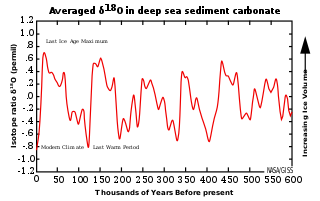 W
WThe 100,000-year problem of the Milankovitch theory of orbital forcing refers to a discrepancy between the reconstructed geologic temperature record and the reconstructed amount of incoming solar radiation, or insolation over the past 800,000 years. Due to variations in the Earth's orbit, the amount of insolation varies with periods of around 21,000, 40,000, 100,000, and 400,000 years. Variations in the amount of incident solar energy drive changes in the climate of the Earth, and are recognised as a key factor in the timing of initiation and termination of glaciations.
 W
WThe African humid period (AHP) is a climate period in Africa during the late Pleistocene and Holocene geologic epochs, when northern Africa was wetter than today. The covering of much of the Sahara desert by grasses, trees and lakes was caused by changes in Earth's orbit around the Sun; changes in vegetation and dust in the Sahara which strengthened the African monsoon; and increased greenhouse gases, which may imply that anthropogenic global warming could result in a shrinkage of the Sahara desert.
 W
WBond events are North Atlantic ice rafting events that are tentatively linked to climate fluctuations in the Holocene. Eight such events have been identified. Bond events were previously believed to exhibit a roughly c. 1,500-year cycle, but the primary period of variability is now put at c. 1,000 years.
 W
WIn paleoclimatology of the Holocene, the Boreal was the first of the Blytt-Sernander sequence of north European climatic phases that were originally based on the study of Danish peat bogs, named for Axel Blytt and Rutger Sernander, who first established the sequence. In peat bog sediments, the Boreal is also recognized by its characteristic pollen zone. It was preceded by the Younger Dryas, the last cold snap of the Pleistocene, and followed by the Atlantic, a warmer and moister period than our most recent climate. The Boreal, transitional between the two periods, varied a great deal, at times having within it climates like today's.
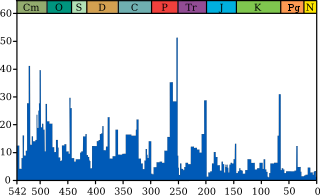 W
WThe Cambrian–Ordovician extinction event occurred approximately 488 million years ago (m.y.a.). This early Phanerozoic Eon extinction event eliminated many brachiopods and conodonts, and severely reduced the number of trilobite species. The Period in the Cambrian extinction in which most of the extinction occurred was the Caerfai Period.
 W
WThe carbonate–silicate geochemical cycle, also known as the inorganic carbon cycle, describes the long-term transformation of silicate rocks to carbonate rocks by weathering and sedimentation, and the transformation of carbonate rocks back into silicate rocks by metamorphism and volcanism. Carbon dioxide is removed from the atmosphere during burial of weathered minerals and returned to the atmosphere through volcanism. On million-year time scales, the carbonate-silicate cycle is a key factor in controlling Earth's climate because it regulates carbon dioxide levels and therefore global temperature.
 W
WThe Carboniferous rainforest collapse (CRC) was a minor extinction event that occurred around 305 million years ago in the Carboniferous period. It altered the vast coal forests that covered the equatorial region of Euramerica. This event may have fragmented the forests into isolated 'islands', which in turn caused dwarfism and, shortly after, extinction of many plant and animal species. Following the event, coal-forming tropical forests continued in large areas of the Earth, but their extent and composition were changed.
 W
WThe clathrate gun hypothesis refers to a proposed explanation for the periods of rapid warming during the Quaternary. The idea is that changes in fluxes in upper intermediate waters in the ocean caused temperature fluctuations that alternately accumulated and occasionally released methane clathrate on upper continental slopes, these events would have caused the Bond Cycles and individual interstadial events, such as the Dansgaard–Oeschger interstadials.
 W
WClimate change includes both the global warming driven by human emissions of greenhouse gases, and the resulting large-scale shifts in weather patterns. Though there have been previous periods of climatic change, since the mid-20th century the rate of human impact on Earth's climate system and its global scale have been unprecedented.
 W
WClimate variability includes all the variations in the climate that last longer than individual weather events, whereas the term climate change only refers to those variations that persist for a longer period of time, typically decades or more. In the time since the industrial revolution the climate has increasingly been affected by human activities that are causing global warming and climate change.
 W
WThe Cretaceous Thermal Maximum (CTM), also known as Cretaceous Thermal Optimum, was a period of climatic warming that reached its peak approximately 90 million years ago during the Turonian age of the Late Cretaceous epoch. The CTM is notable for its dramatic increase in global temperatures characterized by high carbon dioxide levels.
 W
WThe Dalton Minimum was a period of low sunspot count, representing low solar activity, named after the English meteorologist John Dalton, lasting from about 1790 to 1830 or 1796 to 1820, corresponding to the period solar cycle 4 to solar cycle 7. While the Dalton Minimum is often compared with the Maunder Minimum, its sunspot number was slightly higher and reported sunspots distributed in both solar hemispheres unlike the Maunder Minimum. The coronal streamers are visually confirmed in Ezra Ames and José Joaquin de Ferrer’s eclipse drawings in 1806 and indicates similarity of its magnetic field not with that of the Maunder Minimum but with that of the modern solar cycles.
 W
WDansgaard–Oeschger events are rapid climate fluctuations that occurred 25 times during the last glacial period. Some scientists say that the events occur quasi-periodically with a recurrence time being a multiple of 1,470 years, but this is debated. The comparable climate cyclicity during the Holocene is referred to as Bond events.
 W
WAn extinction-level event is a widespread and rapid decrease in the biodiversity on Earth. Such an event is identified by a sharp change in the diversity and abundance of multicellular organisms. It occurs when the rate of extinction increases with respect to the rate of speciation. Estimates of the number of major mass extinctions in the last 540 million years range from as few as five to more than twenty. These differences stem from the threshold chosen for describing an extinction event as "major", and the data chosen to measure past diversity.
 W
WThe global temperature record shows the fluctuations of the temperature of the atmosphere and the oceans through various spans of time. The most detailed information exists since 1850, when methodical thermometer-based records began. There are numerous estimates of temperatures since the end of the Pleistocene glaciation, particularly during the current Holocene epoch. Older time periods are studied by paleoclimatology.
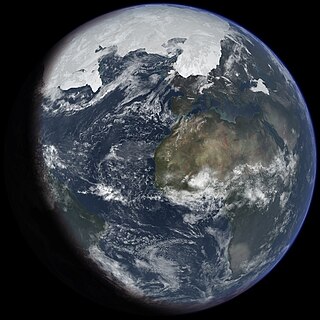 W
WAn ice age is a long period of reduction in the temperature of the Earth's surface and atmosphere, resulting in the presence or expansion of continental and polar ice sheets and alpine glaciers. Earth's climate alternates between ice ages and greenhouse periods, during which there are no glaciers on the planet. Earth is currently in the Quaternary glaciation, known in popular terminology as the Ice Age. Individual pulses of cold climate within an ice age are termed glacial periods, and intermittent warm periods within an ice age are called interglacials or interstadials.
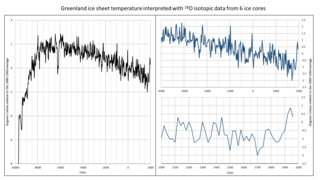 W
WThe Iron Age Cold Epoch was a period of unusually cold climate in the North Atlantic region, lasting from about 900 BC to about 300 BC, with an especially cold wave in 450 BC during the expansion of ancient Greece. It was followed by the Roman Warm Period.
 W
WThe Late Devonian extinction was one of five major extinction events in the history of life on Earth. A major extinction, the Kellwasser event, occurred at the boundary that marks the beginning of the last phase of the Devonian period, the Famennian faunal stage, about 360–376 million years ago. Overall, 19% of all families and 50% of all genera became extinct. A second, distinct mass extinction, the Hangenberg event, closed the Devonian period.
 W
WThe Little Ice Age (LIA) was a period of cooling that occurred after the Medieval Warm Period. Although it was not a true ice age, the term was introduced into scientific literature by François E. Matthes in 1939. It has been conventionally defined as a period extending from the 16th to the 19th centuries, but some experts prefer an alternative timespan from about 1300 to about 1850.
 W
WThe Maunder Minimum, also known as the "prolonged sunspot minimum", is the name used for the period around 1645 to 1715 during which sunspots became exceedingly rare, as was then noted by solar observers.
 W
WThe Medieval Warm Period (MWP) also known as the Medieval Climate Optimum, or Medieval Climatic Anomaly was a time of warm climate in the North Atlantic region lasting from c. 950 to c. 1250. It was likely related to warming elsewhere while some other regions were colder, such as the tropical Pacific. Average global mean temperatures have been calculated to be similar to early-mid-20th-century warming. Possible causes of the Medieval Warm Period include increased solar activity, decreased volcanic activity, and changes to ocean circulation.
 W
WThe Middle Bronze Age Cold Epoch was a period of unusually cold climate in the North Atlantic region, lasting from about 1800 BC to about 1500 BC. It was followed by the Bronze Age Optimum.
 W
WThe neoglaciation describes the documented cooling trend in the Earth's climate during the Holocene, following the retreat of the Wisconsin glaciation, the most recent glacial period. Neoglaciation has followed the hypsithermal or Holocene Climatic Optimum, the warmest point in the Earth's climate during the current interglacial stage. The neoglaciation has no well-marked universal beginning: local conditions and ecological inertia affected the onset of detectably cooler conditions.
 W
WThe Ordovician–Silurian extinction events, also known as the Late Ordovician mass extinction (LOME), are collectively the second-largest of the five major extinction events in Earth's history in terms of percentage of genera that became extinct. Extinction was global during this period, eliminating 49–60% of marine genera and nearly 85% of marine species. Only the Permian-Triassic mass extinction exceeds the LOME in total biodiversity loss. The extinction event abruptly affected all major taxonomic groups and caused the disappearance of one third of all brachiopod and bryozoan families, as well as numerous groups of conodonts, trilobites, echinoderms, corals, bivalves, and graptolites. This extinction was the first of the "big five" Phanerozoic mass extinction events and was the first to significantly affect animal-based communities. However, the LOME did not produce major changes to ecosystem structures compared to other mass extinctions, nor did it lead to any particular morphological innovations. Diversity gradually recovered to pre-extinction levels over the first 5 million years of the Silurian period.
 W
WThe Paleocene–Eocene Thermal Maximum (PETM), alternatively "Eocene thermal maximum 1" (ETM1), and formerly known as the "Initial Eocene" or "Late Paleocene Thermal Maximum", was a time period with a more than 5–8 °C global average temperature rise across the event. This climate event occurred at the time boundary of the Paleocene and Eocene geological epochs. The exact age and duration of the event is uncertain but it is estimated to have occurred around 55.5 million years ago.
 W
WThe Piora Oscillation was an abrupt cold and wet period in the climate history of the Holocene Epoch; it is roughly dated to c. 3900-3000 BC. Some researchers associate the Piora Oscillation with the end of the Atlantic climate regime, and the start of the Sub-Boreal, in the Blytt–Sernander sequence of Holocene climates.
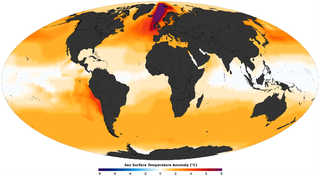 W
WDuring the Pliocene epoch climate became cooler and drier, and seasonal, similar to modern climates.
 W
WThe retreat of glaciers since 1850 affects the availability of fresh water for irrigation and domestic use, mountain recreation, animals and plants that depend on glacier-melt, and, in the longer term, the level of the oceans. Studied by glaciologists, the temporal coincidence of glacier retreat with the measured increase of atmospheric greenhouse gases is often cited as an evidentiary underpinning of global warming. Mid-latitude mountain ranges such as the Himalayas, Rockies, Alps, Cascades, and the southern Andes, as well as isolated tropical summits such as Mount Kilimanjaro in Africa, are showing some of the largest proportionate glacial losses.
 W
WThe Triassic–Jurassic (Tr-J) extinction event, sometimes called the end-Triassic extinction, marks the boundary between the Triassic and Jurassic periods, 201.3 million years ago, and is one of the major extinction events of the Phanerozoic eon, profoundly affecting life on land and in the oceans. In the seas, a whole class (conodonts) and 23–34% of marine genera disappeared. On land, all archosauromorphs other than crocodylomorphs, pterosaurs, and dinosaurs went extinct; some of the groups which died out were previously abundant, such as aetosaurs, phytosaurs, and rauisuchids. Some remaining non-mammalian therapsids and many of the large temnospondyl amphibians had gone extinct prior to the Jurassic as well. However, there is still much uncertainty regarding a connection between the Tr-J boundary and terrestrial vertebrates, due to a paucity of terrestrial fossils from the Rhaetian period of the Triassic. Surprisingly, what was left fairly untouched were plants, dinosaurs, pterosaurs and mammals, this allowed the dinosaurs and pterosaurs to become the dominant land animals for the next 135 million years.